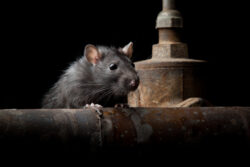We can all appreciate the coziness of a warm house during the colder months, and roof rats are no exception. If you suspect your Florida home has a roof rat infestation, it’s important to keep an eye out for the signs of these nibbling rodents. Educate yourself with helpful pointers from McCall Service’s wildlife control experts to determine whether you’re hosting some unwelcome guests.
1. Droppings and Urine around the House
Roof rat droppings are fairly easy to identify. They’re dark-colored, shaped like grains of rice, and measure ½ of an inch in length. Outdoors, roof rats skulk around thick bushes, in trees, and around power lines. Once they invade your home, however, they’ll huddle in your attic, wall voids, and ceiling to chew on drywall, wiring, and nest in insulation.
So, what does roof rat urine look like? Depending on the surface the rat urine is on, it can be difficult to spot. However, on concrete and hardwood, roof rat urine dries in streaks and becomes chalk-like when dry. You should also look out for rub marks along the baseboards of your home—roof rats’ greasy, dirty fur leaves marks on surfaces they touch.
The waste roof rats leave behind isn’t just disgusting; it can make you sick, too. Roof rats can spread several diseases through their waste, including:
- Hantavirus
- Salmonellosis
- Leptospirosis
When looking for signs of roof rats, however, you’re better off relying on your nose. Roof rat urine emits a strong, ammonia-like odor. As we’ve mentioned, however, breathing in or touching roof rat droppings or urine can be dangerous without the proper equipment or training. Contact McCall Service’s roof rat control experts to avoid the following risks of the nastiest signs of roof rats in your home:
- Risking contamination by using your bare hands
- Stirring up hazardous particles by sweeping waste away with a broom
- Releasing those particles into the air without proper ventilation
If you need to clean up immediately, use gloves, paper towels, and a disinfecting cleaner to eliminate all remnants of rat waste. Air out the house for as long as possible, and wash your hands thoroughly after disposing of the bagged waste and paper towels. Of course, a pest professional makes safe and easy work of getting rid of both pests and their waste.
2. Gnaw Marks on Furniture, Walls, and Exposed Wood
Rodents’ teeth grow continuously, causing them to gnaw on nearly anything in sight. If you find tooth marks on the peanut butter jar lid, the wooden feet of your furniture, or on the beams in your attic, there’s a good chance you’re hosting rodents. Besides the risk of contaminated food, roof rats’ gnawing habits present a major danger.
While their constantly sharpened teeth make it easy for them to chew through heavy-duty plastic and wood, they can also gnaw away at electrical wiring. Getting rid of a roof rat infestation is essential to preventing the risk of electrical fires in your home. At the first signs of roof rats, give McCall Service a call.
3. Scratching Noises in the Walls or Ceiling at Night
The pitter-patter of little feet can be adorable—but not when it comes from roof rats scurrying around in your attic. These rodents can also make scratching sounds from inside walls or the attic as they make their way around the inner structure of your home. Even the aforementioned gnawing can produce its own unique noises. Additionally, roof rats’ size (6 – 8 inches) helps them make even more noise than smaller rodents like mice.
4. Foul, Unexplained Odors in Certain Areas
If your home has been permeated with a mysterious stench, a roof rat corpse could be to blame. Worse even than the odor from their urine, the smell of a dead rodent is hard to miss, and may draw other pests, such as flies. Of course, a powerful smell like this could also be evidence of another type of dead wildlife. Our skilled professionals will take care of the problem in no time.
5. Finding an Actual Roof Rat in Your Home
Pets can be incredibly helpful when it comes to detecting a roof rat infestation. Dogs and cats notice sounds that their human companions can’t. If you often find them staring at a particular wall or another part of your home, there’s a good chance you have rodents. If you see a roof rat, either indoors or outside around trees overhanging your home, there may be many others on your property.
Shield Your Florida Property from Roof Rats with McCall
Understanding how to deal with Florida roof rats in your home can help you resolve the issue quickly. From identifying their waste to keeping an eye out for gnaw marks, learning more about roof rats can help protect your household from these gnawing invaders.
If you think you’re dealing with a roof rat infestation, contact McCall Service right away. Our experienced technicians help safeguard homes and businesses in Florida.



